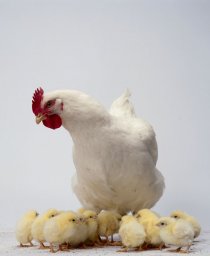Control of Chicken Anemia Virus Infections in Chickens
Due to the widespread distribution of the virus, prevention and control of this disease requires a well coordinated approach, balancing biosecurity / hygienic measures and vaccination. In this respect the presence of maternal immunity is important.
Maternal Immunity
- Maternally derived antibodies (MDA) offer protection against CAV infections
- CAV and related infections do not appear in the progeny of immune breeder flocks.
- The level of protection is directly related to the level of MDA
- The higher the MDA level, the longer the protection in the progeny
- MDA develop after field infections and/or vaccination
- Field infections do not guarantee high and homogenous levels of MDA
- Vaccination is the best way of promptly obtaining high and homogenous levels of MDA
Minimum protection level
Under laboratory conditions it has been proven that a minimum level of MDA is needed to stop vertical transmission.
Design
- Breeders with different levels of MDA were challenged by inoculation with CAV
- Vertical transmission was evaluated by reisolation of CAV from the faeces as this correlates with transmission through the eggs
- Birds with VN titers <7 (log2) still shed the challenge virus
- Birds with a VN titer of 7 (log2) sporadically shed the virus
- Birds with VN titers >7 (log2) did not shed the virus
Conclusion
To avoid vertical transmission, a MDA titer of > 8 log2 is needed. The higher the MDA level, the longer the protection in the progeny.
The following graph illustrates the minimum average MDA titers in breeders as measured in the VN test in order to avoid vertical transmission.


Merck Animal Health headquarters
Go to the Merck Animal Health website to find out more about the company and read about other innovative products available.
